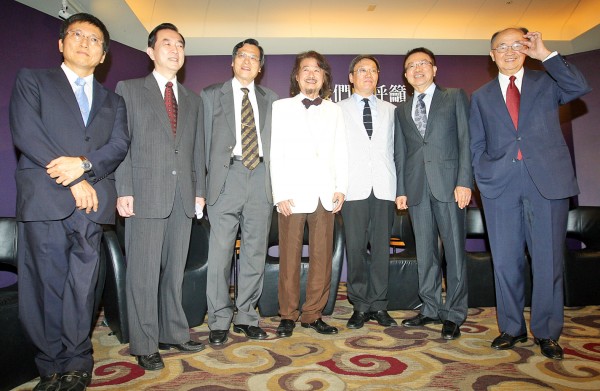《TAIPEI TIMES 焦點》‘Broad one-China framework’ set

A group of politicians and academics headed by former Democratic Progressive Party chairman Shih Ming-te, center, announce their “broad one-China framework” proposal in Taipei yesterday. Photo: CNA
FAMILIAR FACES: The people behind the initiative for an ‘international legal persona of the ROC and the PRC’ include former officials, and KMT and DPP members
By Lee I-chia / Staff reporter
Seven politicians and academics, headed by former Democratic Progressive Party (DPP) chairman Shih Ming-te (施明德), yesterday unveiled the “five principles” of a proposal, named the “broad one-China framework” (大一中原則), that they say could resolve the domestic political divide and stalemated cross-strait relations.
The group crosses party lines, and includes former Mainland Affairs Council vice chairman Chen Ming-tung (陳明通), who served under the DPP administration, and former National Security Council secretary-general Su Chi (蘇起), who served under President Ma Ying-jeou’s (馬英九) administration.
Shih said the five principles include “respecting the present ‘status quo’ and not changing it unilaterally,” adding that the “status quo” is that the Republic of China (ROC) and People’s Republic of China (PRC) have coexisted since 1949, with bilateral relations seeing a gradual transformation from “fighting with each other” to “governing separately.”
The “broad one-China framework” is aimed at establishing an international legal entity — consisting of the ROC and the PRC — for resolving issues through consensus, and serving as an interim scheme, Shih said.
The two sides under the framework should strive to eliminate hostility and work together to maintain peace and safety in the region, Shih said.
Both sides should promise not to use military force or sign any military agreement that is unfavorable to the other side, and both should be allowed to join international organizations, such as the UN, and establish normal state relations with other countries, he said.
“The five principles cannot be taken apart, they are like a set meal,” Shih said.
He said the initiative was inspired by the Chinese Civil War and Taiwan’s decades-long Martial Law era that for many years created deep hostility and divisions among the people, adding that political manipulations for election purposes have led to a great division between the pan-blue and pan-green camps to the point that they cannot communicate with the other.
Beijing’s “one country, two systems” or the “Hong Kong model” under its “one China principle” would not be accepted by Taiwanese, while neither the Chinese Nationalist Party’s (KMT) “one China with different interpretations” policy or the DPP’s “ROC equals Taiwan” proposal have found support, Shih said.
The civil war between the Chinese Communist Party (CCP) and KMT has led to animosity, but Taiwanese in general have no hatred toward China, so the PRC should try to understand why the Taiwanese cannot accept its claim of goodwill toward Taiwan, instead of believing that reconciliation with KMT means Beijing can take over the fate of the people of Taiwan, he said.
Su, a confidant of Ma, said that the Ma administration’s “three noes” — “no unification, no independence, no use of force”— is too passive, and could neither adapt to a changing environment nor solve future problems.
The nation’s challenges of the “big triangle” — the relations between the US, PRC and the ROC — and the “small triangle — the relations between the CCP, the KMT and the DPP — have become unstable, Su said.
Taiwan needs to initiate a creative scheme to create its own future, he said.
Responding to a question on whether the sovereignty of the PRC and the ROC under the proposed framework would be “separate” or “overlapping,” Su said that ambiguity could sometimes lead to better cross-strait relations.
“When things are explained clearer, the less flexible it is ... it would be troublesome if you only have two choices all the time … a certain amount of ambiguity is beautiful,” he said.
One of the most prominent China experts in the DPP, Chen said he thinks the five principles are a feasible compromise between the pan-blue and pan-green camps, but any proposition for improving cross-strait relations must be decided by the 23 million Taiwan ese through a national referendum.
The other five people behind the “broad one-China framework” are Tamkang University Graduate Institute of China Studies director Andy Chang (張五岳), former DPP legislator Hong Chi-chang (洪奇昌), former minister of foreign affairs Cheng Chien-jen (程建人) and former Straits Exchange Foundation vice chairman Chiao Jen-ho (焦仁和).
Hong and Chiao are both KMT members.
Shih, who was a political prisoner for more than 25 years under the former KMT administration, resigned from the DPP in 2000.
In 2006, he helped lead protests against the DPP government of former president Chen Shui-bian (陳水扁).
新聞來源:TAIPEI TIMES














